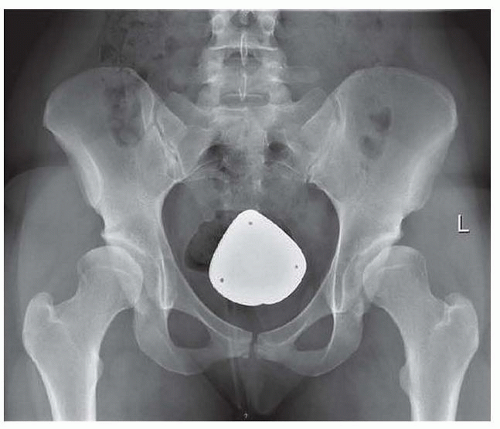Hip Arthroscopy
John P. Salvo
Daniel P. Woods
DEFINITION
Hip arthroscopy is a minimally invasive technique to address a variety of painful hip conditions in the athletic and prearthritic population.
A surge in technologic development since the mid-1990s has allowed surgeons to effectively and reliably treat a variety of painful hip conditions arthroscopically.
The outcomes of hip arthroscopic techniques are equivocal to traditional, more invasive open techniques.2
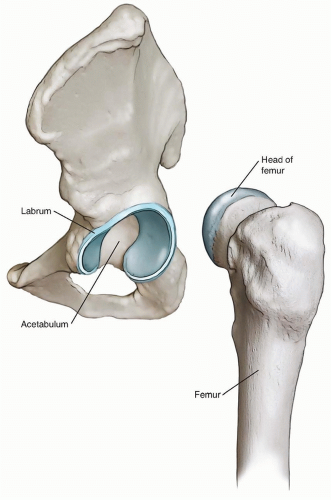
FIG 1 • Picture represents the bony and soft tissue anatomy of the hip joint. Femoral head, acetabulum, articular cartilage, and labrum are shown.
There is a tremendous learning curve when compared to knee and shoulder arthroscopy.
ANATOMY
The hip is a constrained ball-and-socket joint, with the femoral head (ball) articulating with the acetabulum (socket) of the pelvis (FIG 1).
The labrum is a pad of fibrocartilage attached to the acetabulum that deepens the acetabulum and provides stability to the
hip as well as a “suction-seal” effect around the femoral head, providing a secure environment for the articular cartilage and synovial fluid6 (FIG 2).
The alignment and shape of the hip is critical when determining the etiology of hip pain and thus proper treatment.
Femoroacetabular impingement (FAI) refers to a bony over-constraint of the joint either from the femur (cam) or acetabulum (pincer) or both (combined)11 (FIGS 3 and 4)
PATHOGENESIS
Hip and groin pain in athletic and prearthritic population has a wide variety of etiologies:
Labral tear
FAI
Loose bodies
Osteoarthritis
Core muscle injury (also known as sports hernia)
Labral tear is the most common cause of hip pain and dysfunction in this population.
Labral tears are usually secondary to FAI or dysplasia or both.
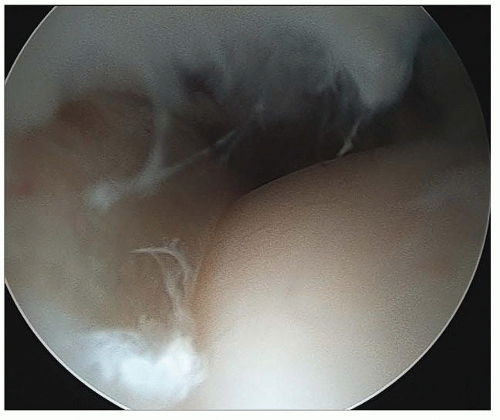
FIG 2 • Arthroscopic picture showing the femoral head (right) and the labrum (left) and the suction-seal effect of a normal labrum with the hip off traction.
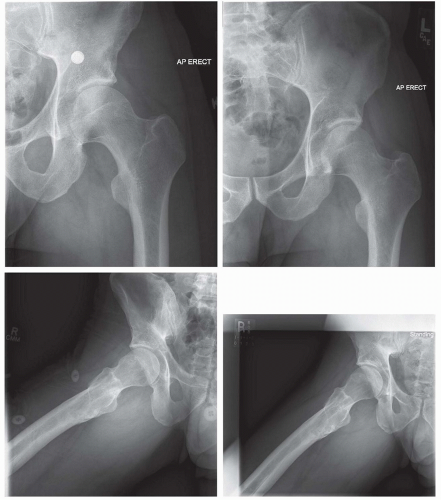
FIG 4 • X-rays preoperative weight-bearing views AP and lateral of hip with mixed FAI. Postoperative AP and lateral views after femoroplasty and acetabuloplasty.
If left unchecked, FAI may lead to early development of degenerative joint disease.7
NATURAL HISTORY
Labral tear
If left untreated, labral tears can lead to continued pain and dysfunction as well as damage to the adjacent articular cartilage.
FAI
If left untreated, many believe that FAI is a precursor to arthritis.
If treated at the appropriate time before irreversible articular cartilage damage occurs, the hip may be preserved.
Loose bodies
If left untreated, loose bodies will lead to articular cartilage damage and continued pain and dysfunction.9
Snapping hip
PATIENT HISTORY AND PHYSICAL FINDINGS
A thorough and focused physical examination is essential.
Observe gait, manual motor testing, palpation of bony prominences and tendons, range of motion (ROM), and provocative maneuvers for reproducing pain and symptoms.
Perform the examination on the asymptomatic hip first to assess the ROM and stability of the normal hip when possible.
IMAGING AND OTHER DIAGNOSTIC STUDIES
Weight-bearing x-rays (anteroposterior [AP] pelvis, frog lateral, false profile, and Dunn 45-degree views)10
High resolution magnetic resonance imaging (MRI). Direct MRI arthrogram allows injection of lidocaine to determine if pain is generated from hip.
Computed tomography (CT) scan allows the best detailed determination of FAI and alignment (dysplasia or version) and allows for detailed preoperative planning for decompression of FAI.10
DIFFERENTIAL DIAGNOSIS
Labral tear
FAI
Loose bodies
Synovitis
Snapping hip
Articular cartilage disease
Arthritis
NONOPERATIVE MANAGEMENT
Nonoperative management is always the first step in the treatment of painful hip conditions in the athletic and prearthritic population.
Activity modification; physical therapy aimed at restoring strength, motion, and balance; and nonsteroidal antiinflammatory drugs or other medications are the mainstays of nonoperative treatment.11
The success of treatment depends on the etiology of the hip pain and the patient’s activity level (college or professional athlete or “weekend warrior”) and age.
SURGICAL MANAGEMENT
The vast majority of patients treated with hip arthroscopy have a combination of labral tear and FAI.
The goal of surgical treatment is to repair the labrum, treat any articular cartilage injury, and restore the normal biomechanics of the hip joint (ie, decompressing the FAI).
Preoperative Planning
Weight-bearing x-rays (AP pelvis, frog lateral, false profile, and Dunn 45-degree views)
Be sure to determine that the pain generates from the hip joint and is not referred (lumbar spine or sacroiliac joint) or from muscular pathology (core muscle injury or sports hernia).
Be wary of other pathology such as dysplasia, connective tissue disorders, or myofascial pain syndrome.
Make sure all appropriate equipment and personnel (eg, radiology technician) are available.
Positioning
Distraction is required for hip arthroscopy as well as fluoroscopic visualization of the joint in all planes.
Place the patient in the supine or lateral position on either a fracture table or commercially available distraction table to allow appropriate distraction of the hip (FIG 6).
A well-padded perineal post, preferably with a lateralized post, should be used to allow distraction in the plane of the femoral neck.
Approach
Standard portals (FIG 7)
Anterolateral
Anterior
Midanterior
Posterolateral
Accessory portals
Modified anterior
Proximal midanterior
Distal lateral portal
Proximal lateral portal
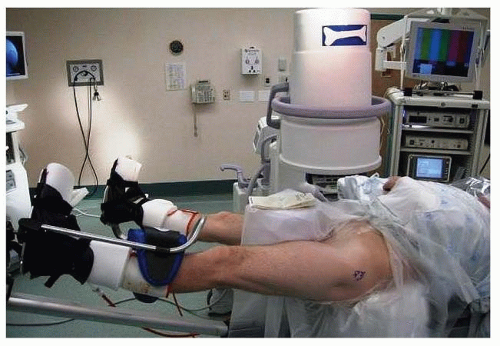
FIG 6 • Patient positioned supine on a hip distractor attached to operating room (OR) table. Full access for C-arm is noted.
Stay updated, free articles. Join our Telegram channel

Full access? Get Clinical Tree



